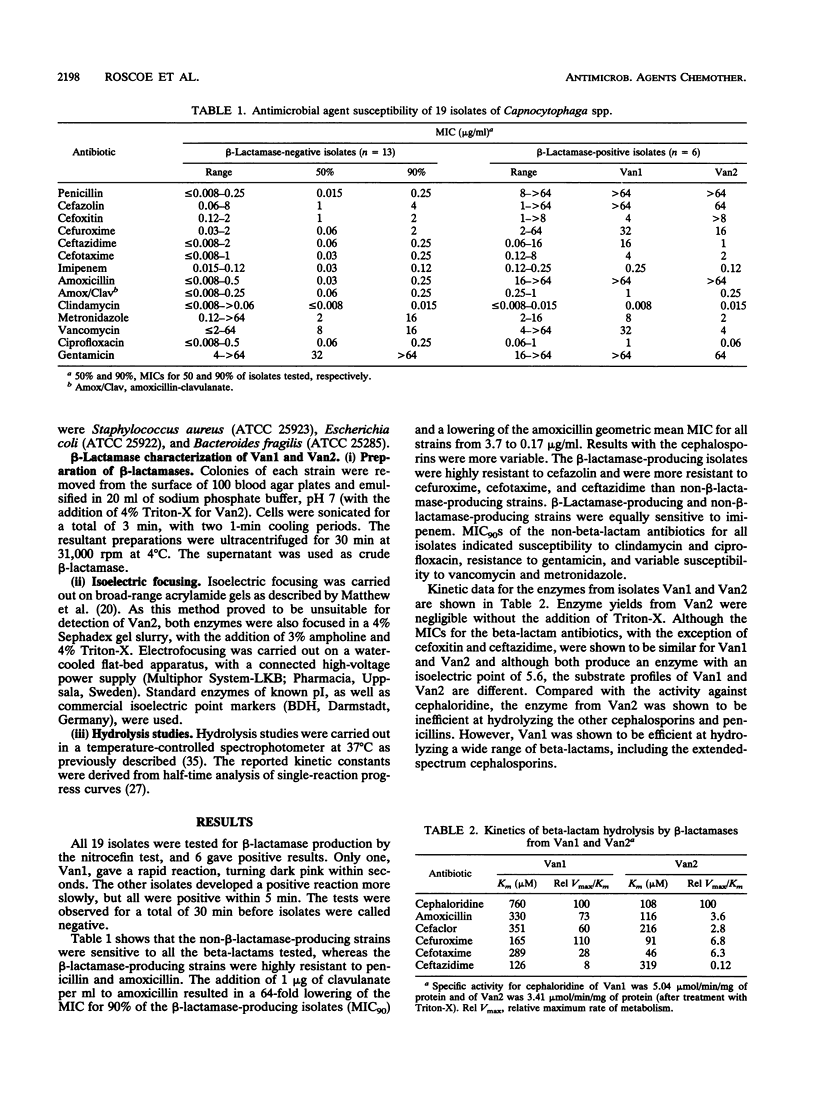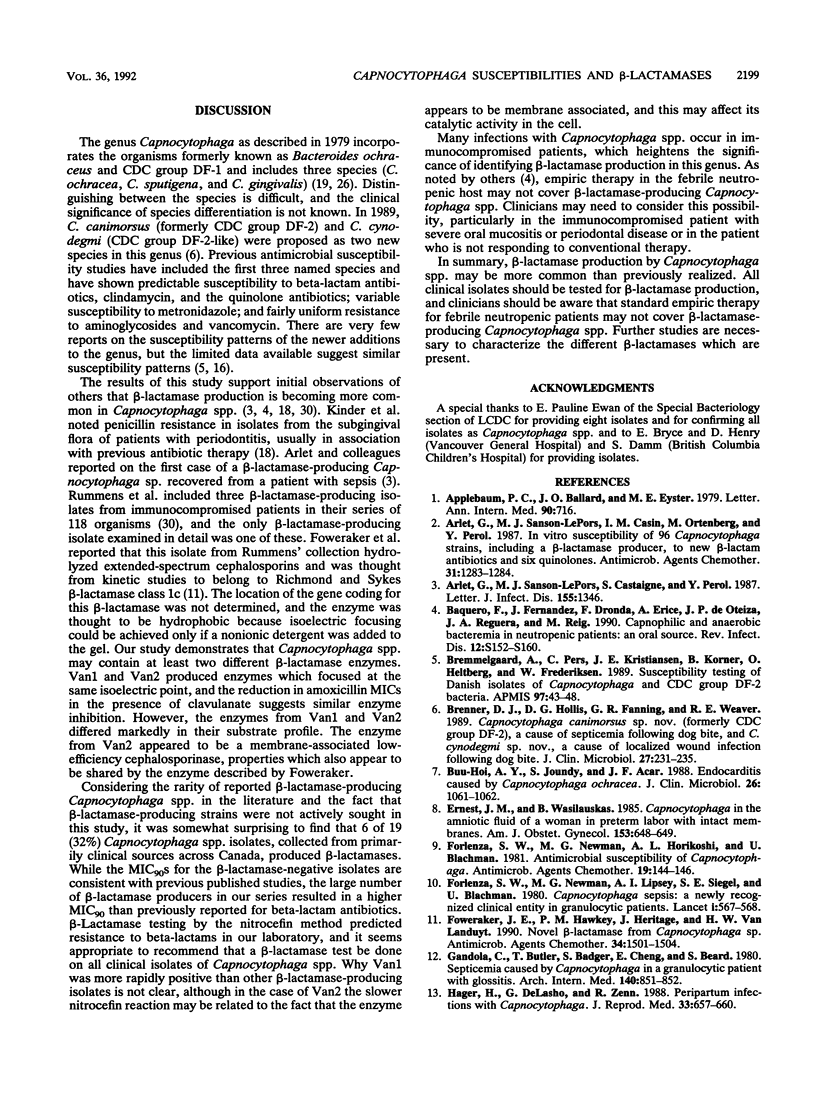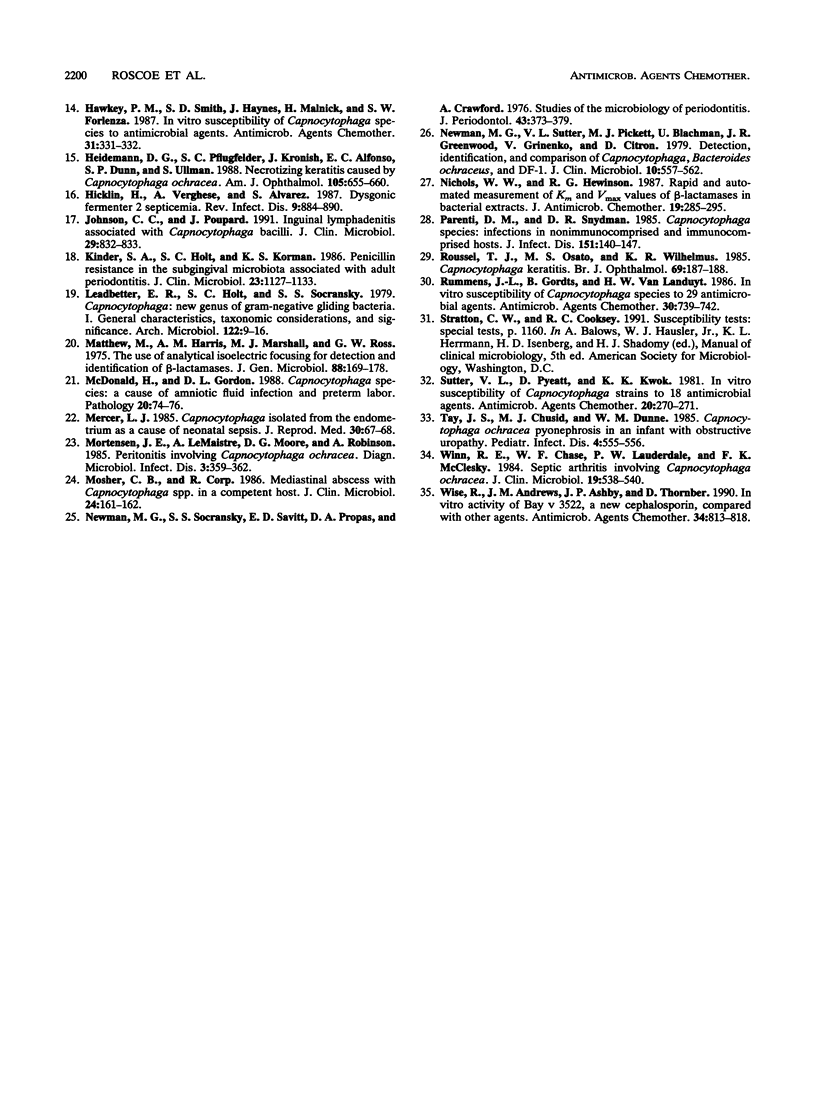Abstract
Capnocytophaga species have been associated with a wide variety of infections in both immunocompetent and immunocompromised patients. On the basis of data from antimicrobial susceptibility studies, beta-lactam antibiotics have been considered efficacious therapy. Six of 19 isolates from primarily clinical sources across Canada demonstrated beta-lactamase production, and agar dilution susceptibility testing showed broad resistance to beta-lactam antibiotics. For the beta-lactamase producing isolates, clavulanate reduced the MIC of amoxicillin for 90% of the strains tested by 64-fold. Isolates were highly susceptible to clindamycin, imipenem, and ciprofloxacin. Characterization of the beta-lactamases produced by two of these isolates (Van1 and Van2) was performed. Isoelectric focusing revealed an identical isoelectric point of 5.6 for both enzymes, but they had markedly different relative hydrolysis efficiencies, and different conditions were required to extract the enzymes. This study demonstrates the production of different types of beta-lactamases by Capnocytophaga spp. and suggests the need to screen all clinical isolates of Capnocytophaga spp. for the presence of beta-lactamases.
Full text
PDF



Selected References
These references are in PubMed. This may not be the complete list of references from this article.
- Appelbaum P. C., Ballard J. O., Eyster M. E. Septicemia due to Capnocytophaga (Bacteroides ocharaceus) in Hodgkin's disease. Ann Intern Med. 1979 Apr;90(4):716–717. doi: 10.7326/0003-4819-90-4-716. [DOI] [PubMed] [Google Scholar]
- Arlet G., Sanson-Le Pors M. J., Casin I. M., Ortenberg M., Perol Y. In vitro susceptibility of 96 Capnocytophaga strains, including a beta-lactamase producer, to new beta-lactam antibiotics and six quinolones. Antimicrob Agents Chemother. 1987 Aug;31(8):1283–1284. doi: 10.1128/aac.31.8.1283. [DOI] [PMC free article] [PubMed] [Google Scholar]
- Arlet G., Sanson-Le Pors M. J., Castaigne S., Perol Y. Isolation of a strain of beta-lactamase-producing Capnocytophaga ochracea. J Infect Dis. 1987 Jun;155(6):1346–1346. doi: 10.1093/infdis/155.6.1346. [DOI] [PubMed] [Google Scholar]
- Baquero F., Fernández J., Dronda F., Erice A., Pérez de Oteiza J., Reguera J. A., Reig M. Capnophilic and anaerobic bacteremia in neutropenic patients: an oral source. Rev Infect Dis. 1990 Jan-Feb;12 (Suppl 2):S157–S160. doi: 10.1093/clinids/12.supplement_2.s157. [DOI] [PubMed] [Google Scholar]
- Bremmelgaard A., Pers C., Kristiansen J. E., Korner B., Heltberg O., Frederiksen W. Susceptibility testing of Danish isolates of Capnocytophaga and CDC group DF-2 bacteria. APMIS. 1989 Jan;97(1):43–48. doi: 10.1111/j.1699-0463.1989.tb00753.x. [DOI] [PubMed] [Google Scholar]
- Brenner D. J., Hollis D. G., Fanning G. R., Weaver R. E. Capnocytophaga canimorsus sp. nov. (formerly CDC group DF-2), a cause of septicemia following dog bite, and C. cynodegmi sp. nov., a cause of localized wound infection following dog bite. J Clin Microbiol. 1989 Feb;27(2):231–235. doi: 10.1128/jcm.27.2.231-235.1989. [DOI] [PMC free article] [PubMed] [Google Scholar]
- Buu-Hoi A. Y., Joundy S., Acar J. F. Endocarditis caused by Capnocytophaga ochracea. J Clin Microbiol. 1988 May;26(5):1061–1062. doi: 10.1128/jcm.26.5.1061-1062.1988. [DOI] [PMC free article] [PubMed] [Google Scholar]
- Ernest J. M., Wasilauskas B. Capnocytophaga in the amniotic fluid of a woman in preterm labor with intact membranes. Am J Obstet Gynecol. 1985 Nov 15;153(6):648–649. doi: 10.1016/s0002-9378(85)80251-9. [DOI] [PubMed] [Google Scholar]
- Forlenza S. W., Newman M. G., Horikoshi A. L., Blachman U. Antimicrobial susceptibility of Capnocytophaga. Antimicrob Agents Chemother. 1981 Jan;19(1):144–146. doi: 10.1128/aac.19.1.144. [DOI] [PMC free article] [PubMed] [Google Scholar]
- Forlenza S. W., Newman M. G., Lipsey A. I., Siegel S. E., Blachman U. Capnocytophaga sepsis: a newly recognised clinical entity in granulocytopenic patients. Lancet. 1980 Mar 15;1(8168 Pt 1):567–568. doi: 10.1016/s0140-6736(80)91057-0. [DOI] [PubMed] [Google Scholar]
- Foweraker J. E., Hawkey P. M., Heritage J., Van Landuyt H. W. Novel beta-lactamase from Capnocytophaga sp. Antimicrob Agents Chemother. 1990 Aug;34(8):1501–1504. doi: 10.1128/aac.34.8.1501. [DOI] [PMC free article] [PubMed] [Google Scholar]
- Gandola C., Butler T., Badger S., Cheng E., Beard S. Septicemia caused by Capnocytophaga in a granulocytopenic patient with glossitis. Arch Intern Med. 1980 Jun;140(6):851–852. [PubMed] [Google Scholar]
- Hager H., DeLasho G., Zenn R. Peripartum infections with Capnocytophaga. A case report. J Reprod Med. 1988 Jul;33(7):657–660. [PubMed] [Google Scholar]
- Hawkey P. M., Smith S. D., Haynes J., Malnick H., Forlenza S. W. In vitro susceptibility of Capnocytophaga species to antimicrobial agents. Antimicrob Agents Chemother. 1987 Feb;31(2):331–332. doi: 10.1128/aac.31.2.331. [DOI] [PMC free article] [PubMed] [Google Scholar]
- Heidemann D. G., Pflugfelder S. C., Kronish J., Alfonso E. C., Dunn S. P., Ullman S. Necrotizing keratitis caused by Capnocytophaga ochracea. Am J Ophthalmol. 1988 Jun 15;105(6):655–660. doi: 10.1016/0002-9394(88)90060-8. [DOI] [PubMed] [Google Scholar]
- Hicklin H., Verghese A., Alvarez S. Dysgonic fermenter 2 septicemia. Rev Infect Dis. 1987 Sep-Oct;9(5):884–890. doi: 10.1093/clinids/9.5.884. [DOI] [PubMed] [Google Scholar]
- Johnson C. C., Poupard J. Inguinal lymphadenitis associated with Capnocytophaga bacilli. J Clin Microbiol. 1991 Apr;29(4):832–833. doi: 10.1128/jcm.29.4.832-833.1991. [DOI] [PMC free article] [PubMed] [Google Scholar]
- Kinder S. A., Holt S. C., Korman K. S. Penicillin resistance in the subgingival microbiota associated with adult periodontitis. J Clin Microbiol. 1986 Jun;23(6):1127–1133. doi: 10.1128/jcm.23.6.1127-1133.1986. [DOI] [PMC free article] [PubMed] [Google Scholar]
- Leadbetter E. R., Holt S. C., Socransky S. S. Capnocytophaga: new genus of gram-negative gliding bacteria. I. General characteristics, taxonomic considerations and significance. Arch Microbiol. 1979 Jul;122(1):9–16. doi: 10.1007/BF00408040. [DOI] [PubMed] [Google Scholar]
- Mathew A., Harris A. M., Marshall M. J., Ross G. W. The use of analytical isoelectric focusing for detection and identification of beta-lactamases. J Gen Microbiol. 1975 May;88(1):169–178. doi: 10.1099/00221287-88-1-169. [DOI] [PubMed] [Google Scholar]
- McDonald H., Gordon D. L. Capnocytophaga species: a cause of amniotic fluid infection and preterm labour. Pathology. 1988 Jan;20(1):74–76. doi: 10.3109/00313028809085203. [DOI] [PubMed] [Google Scholar]
- Mortensen J. E., LeMaistre A., Moore D. G., Robinson A. Peritonitis involving Capnocytophaga ochracea. Diagn Microbiol Infect Dis. 1985 Jul;3(4):359–362. doi: 10.1016/0732-8893(85)90011-2. [DOI] [PubMed] [Google Scholar]
- Mosher C. B., Corp R. Mediastinal abscess with Capnocytophaga spp. in a competent host. J Clin Microbiol. 1986 Jul;24(1):161–162. doi: 10.1128/jcm.24.1.161-162.1986. [DOI] [PMC free article] [PubMed] [Google Scholar]
- Newman M. G., Socransky S. S., Savitt E. D., Propas D. A., Crawford A. Studies of the microbiology of periodontosis. J Periodontol. 1976 Jul;47(7):373–379. doi: 10.1902/jop.1976.47.7.373. [DOI] [PubMed] [Google Scholar]
- Newman M. G., Sutter V. L., Pickett M. J., Blachman U., Greenwood J. R., Grinenko V., Citron D. Detection, identification, and comparison of Capnocytophaga, Bacteroides ochraceus, and DF-1. J Clin Microbiol. 1979 Oct;10(4):557–562. doi: 10.1128/jcm.10.4.557-562.1979. [DOI] [PMC free article] [PubMed] [Google Scholar]
- Nichols W. W., Hewinson R. G. Rapid and automated measurement of Km and specific Vmax values of beta-lactamases in bacterial extracts. J Antimicrob Chemother. 1987 Mar;19(3):285–295. doi: 10.1093/jac/19.3.285. [DOI] [PubMed] [Google Scholar]
- Parenti D. M., Snydman D. R. Capnocytophaga species: infections in nonimmunocompromised and immunocompromised hosts. J Infect Dis. 1985 Jan;151(1):140–147. doi: 10.1093/infdis/151.1.140. [DOI] [PubMed] [Google Scholar]
- Roussel T. J., Osato M. S., Wilhelmus K. R. Capnocytophaga keratitis. Br J Ophthalmol. 1985 Mar;69(3):187–188. doi: 10.1136/bjo.69.3.187. [DOI] [PMC free article] [PubMed] [Google Scholar]
- Rummens J. L., Gordts B., Van Landuyt H. W. In vitro susceptibility of Capnocytophaga species to 29 antimicrobial agents. Antimicrob Agents Chemother. 1986 Nov;30(5):739–742. doi: 10.1128/aac.30.5.739. [DOI] [PMC free article] [PubMed] [Google Scholar]
- Sutter V. L., Pyeatt D., Kwok Y. Y. In vitro susceptibility of Capnocytophaga strains to 18 antimicrobial agents. Antimicrob Agents Chemother. 1981 Aug;20(2):270–271. doi: 10.1128/aac.20.2.270. [DOI] [PMC free article] [PubMed] [Google Scholar]
- Tay J. S., Chusid M. J., Dunne W. M., Jr Capnocytophaga ochracea pyonephrosis in an infant with obstructive nephropathy. Pediatr Infect Dis. 1985 Sep-Oct;4(5):555–556. doi: 10.1097/00006454-198509000-00025. [DOI] [PubMed] [Google Scholar]
- Winn R. E., Chase W. F., Lauderdale P. W., McCleskey F. K. Septic arthritis involving Capnocytophaga ochracea. J Clin Microbiol. 1984 Apr;19(4):538–540. doi: 10.1128/jcm.19.4.538-540.1984. [DOI] [PMC free article] [PubMed] [Google Scholar]
- Wise R., Andrews J. M., Ashby J. P., Thornber D. In vitro activity of Bay v 3522, a new cephalosporin, compared with activities of other agents. Antimicrob Agents Chemother. 1990 May;34(5):813–818. doi: 10.1128/aac.34.5.813. [DOI] [PMC free article] [PubMed] [Google Scholar]


